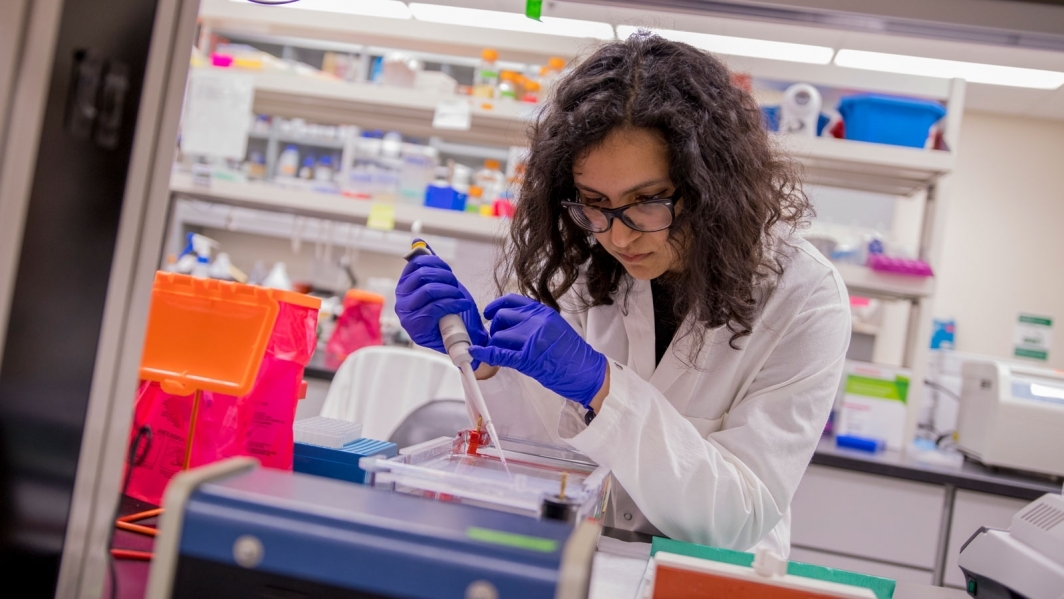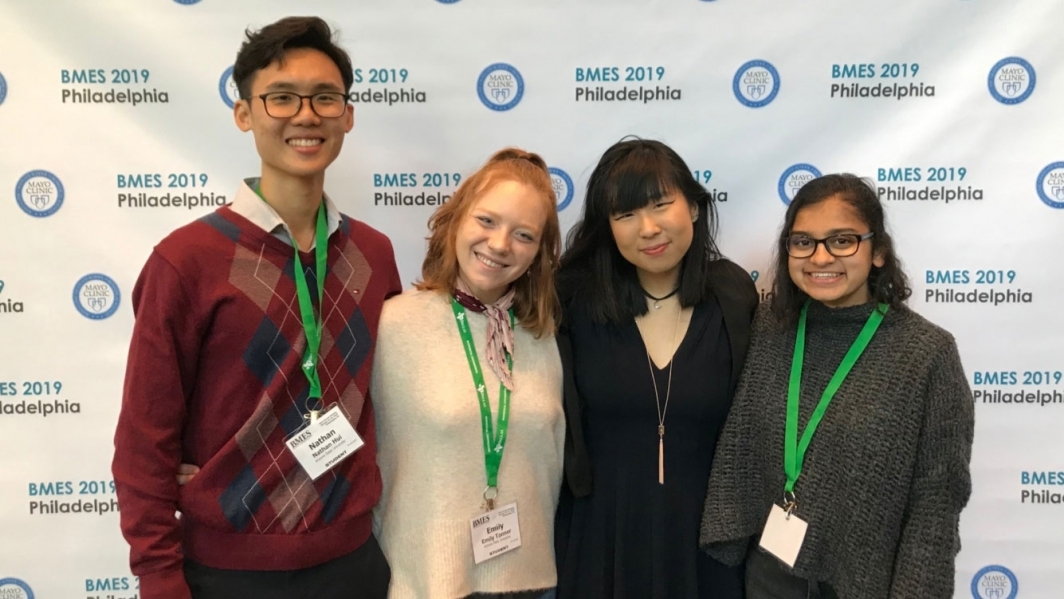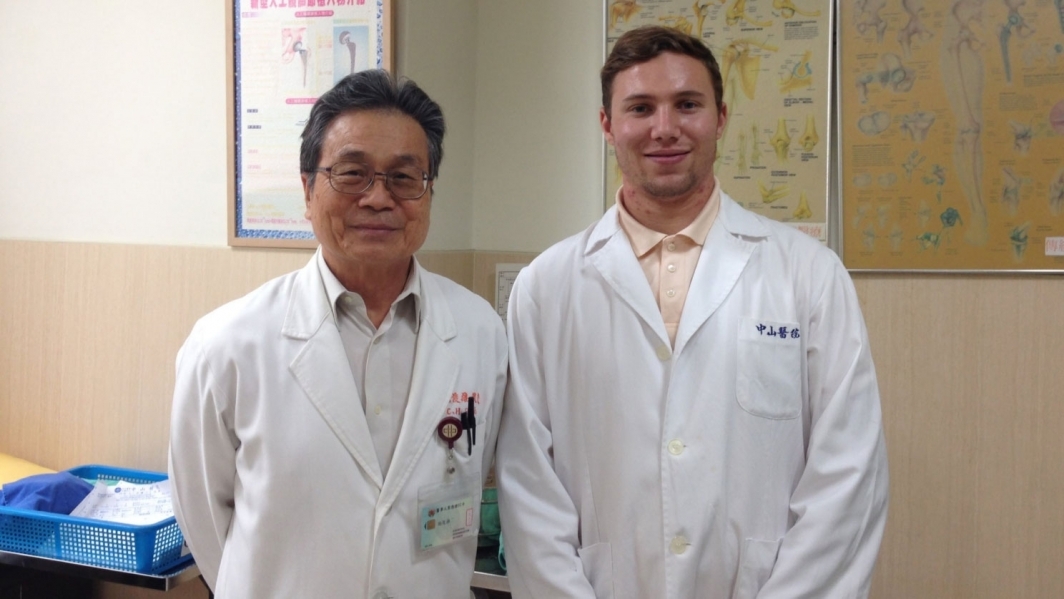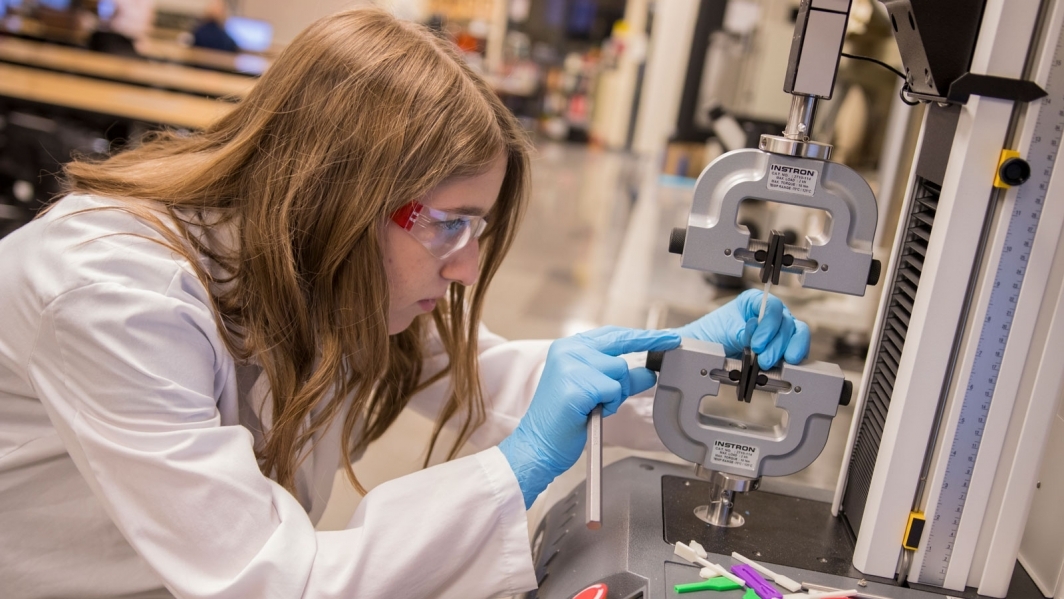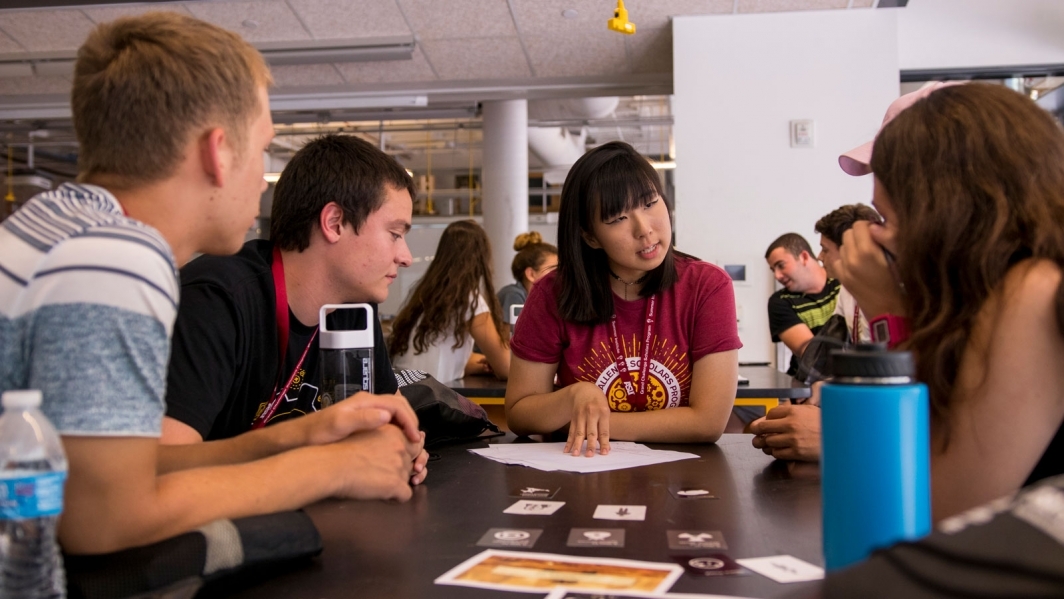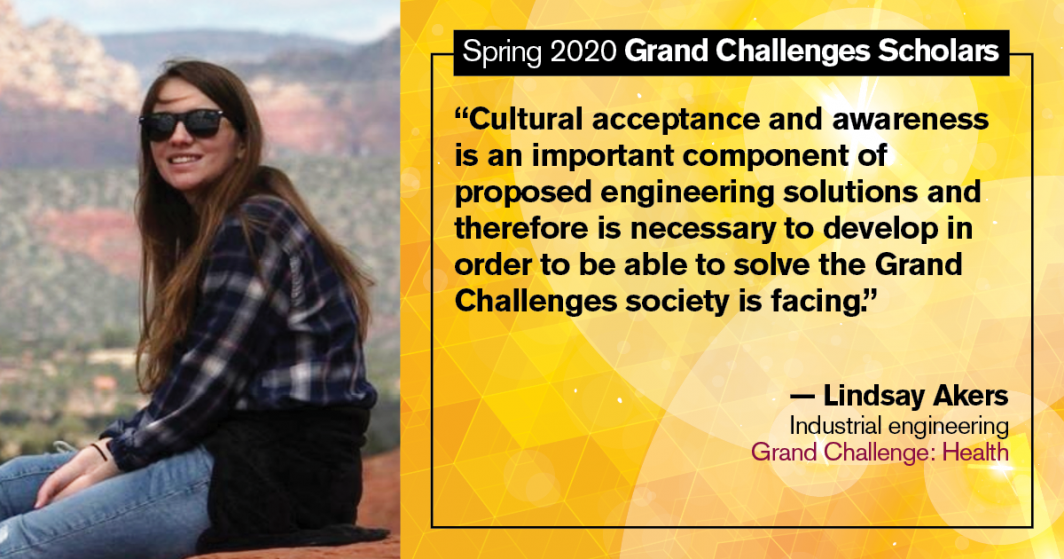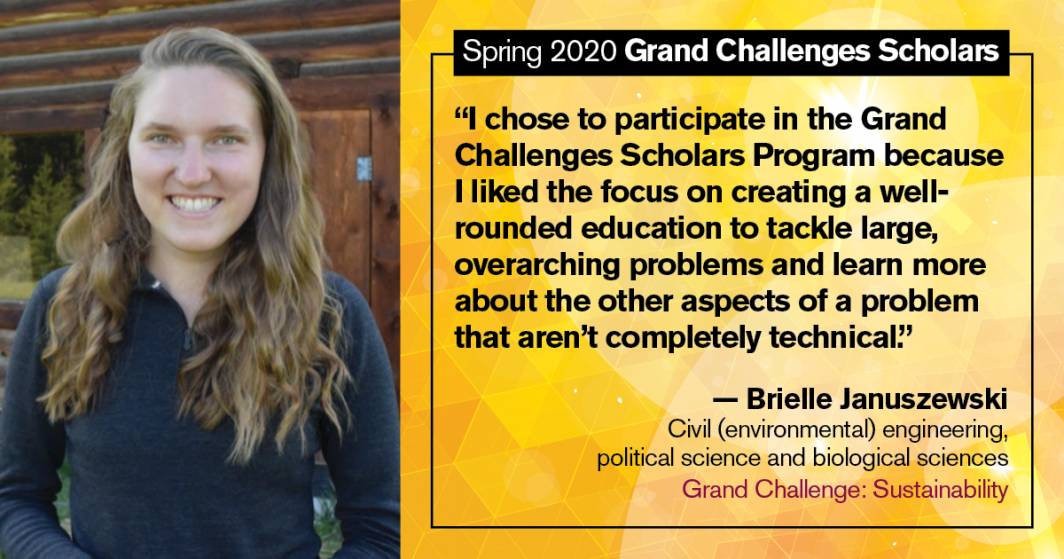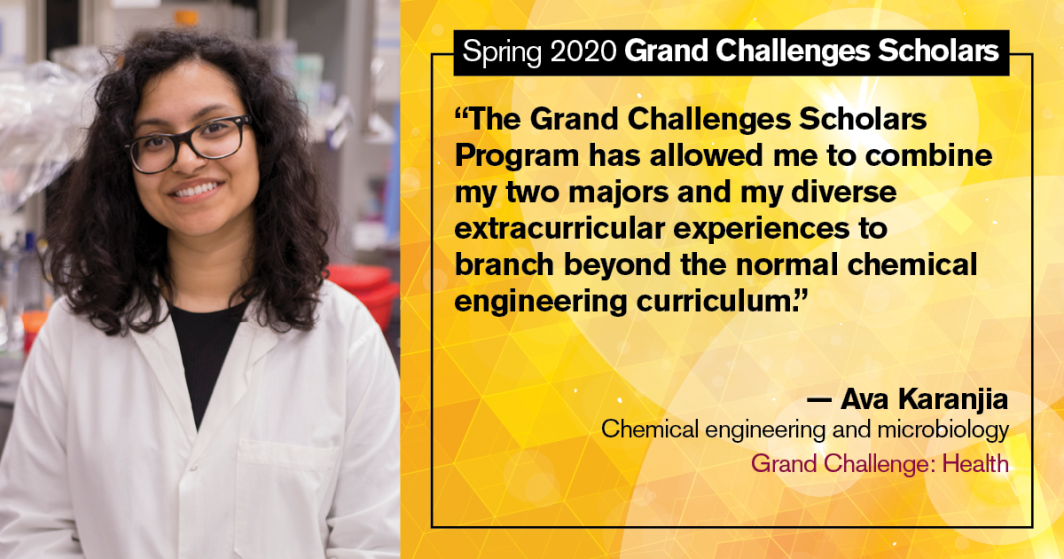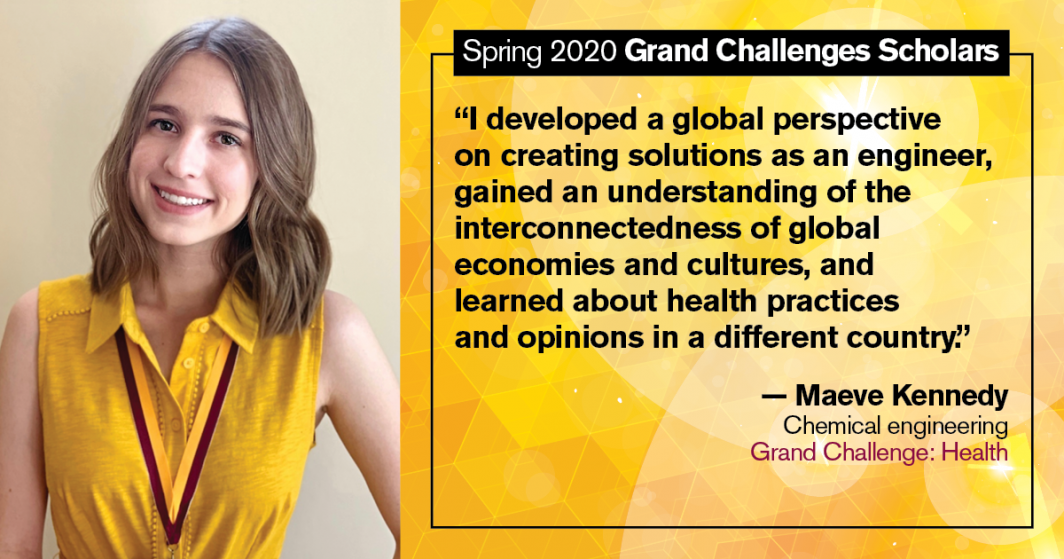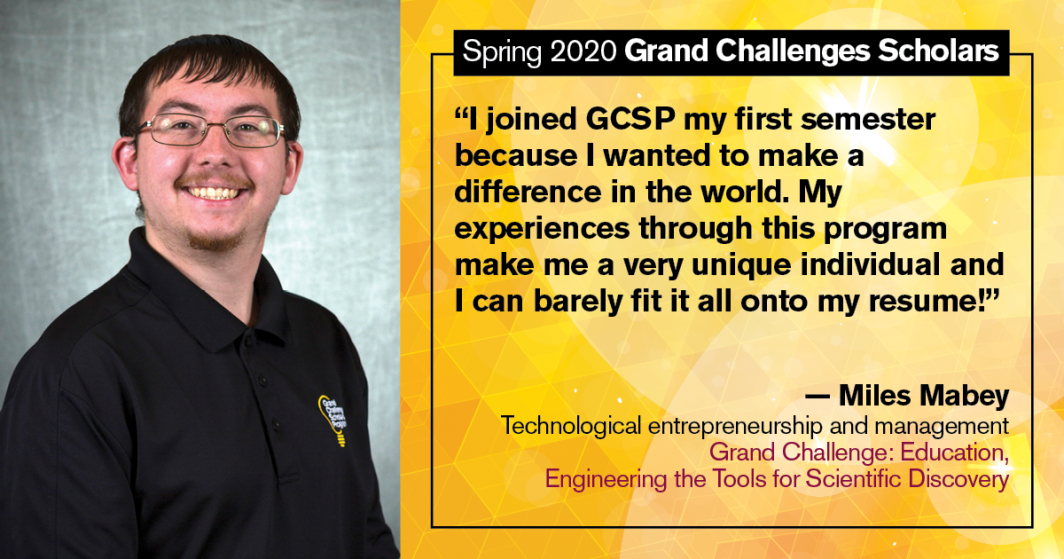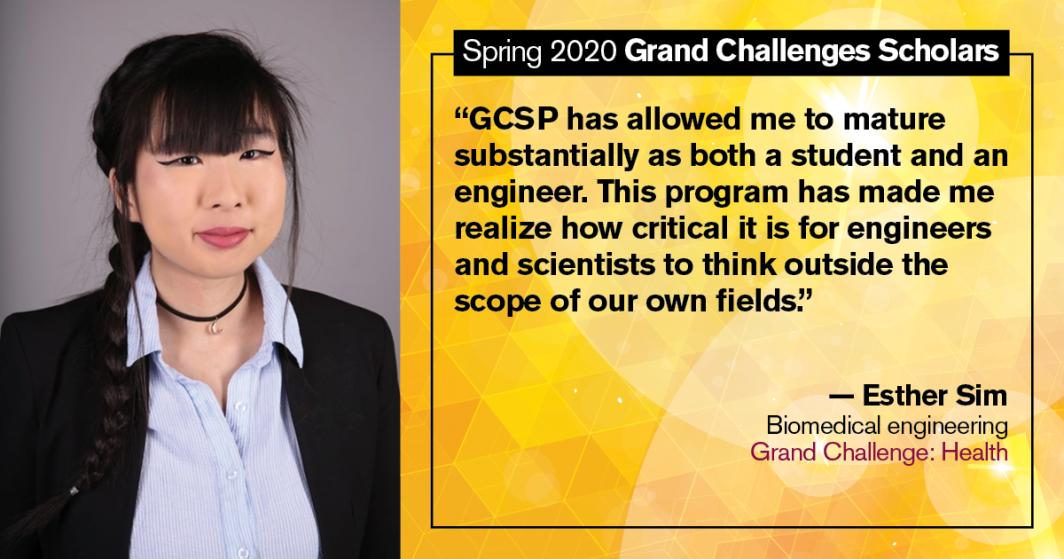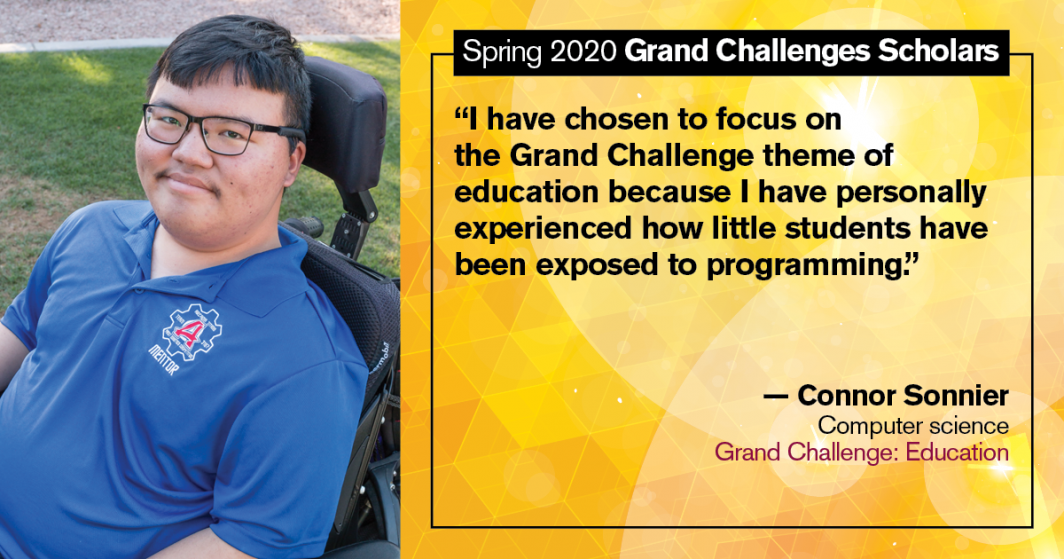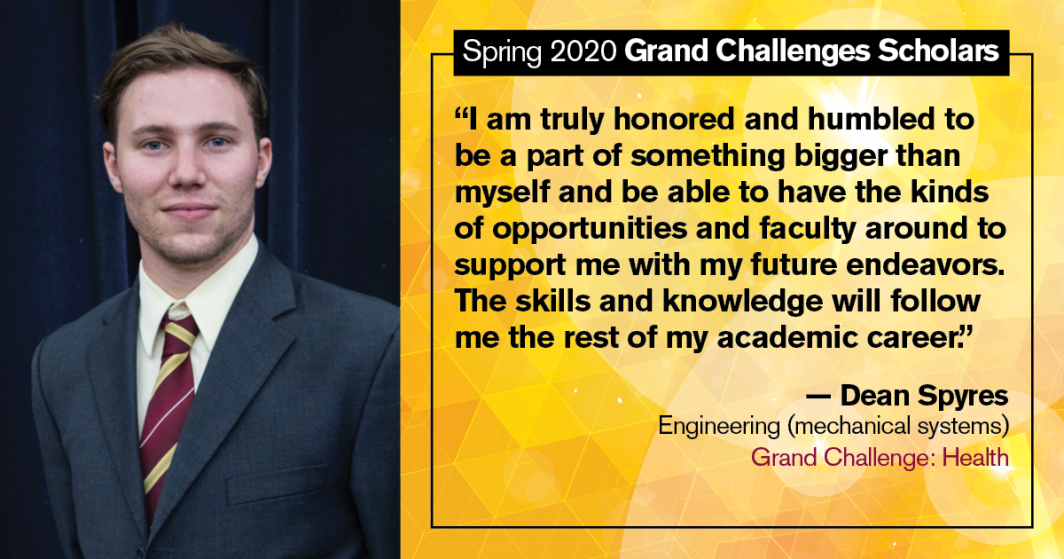ASU Grand Challenges Scholars ready to face a changing world

Students in the Arizona State University Grand Challenges Scholars Program prepare to address global concerns through competencies that impart an ability to see the big picture, consider all aspects of a problem and create value for society. In the spring of 2020, eight new Grand Challenges Scholars graduated to begin tackling global challenges in health, sustainability, education and more. Photo by Connor McKee/ASU
In the middle of a global pandemic, it’s clear the world is intensely interconnected. If we’re going to address global challenges, we need engineers who can see the big picture, collaborate across disciplines and work on diverse teams to find solutions.
For students who want to take on such ambitious goals, the Ira A. Fulton Schools of Engineering offers the Grand Challenges Scholars Program, known as GCSP. Endorsed by the National Academy of Engineering, or NAE, and Arizona State University, the program provides the tools and unrivaled experiences students need to become agents of change.
“The challenges we face as a global society are complex; it is important for engineers to look beyond the technical and recognize other types of people and information they must work with to effectively address them,” said Amy Trowbridge, GCSP director.
To become an NAE Grand Challenges Scholar, students must demonstrate five competencies through research or a creative project, multidisciplinary learning, entrepreneurship, multicultural experience and a service-learning project. Completing these requirements imparts an ability to see the big picture, to consider all aspects of a problem and to create value for society.
Upon completion, ASU Grand Challenges Scholars earn national recognition from the National Academy of Engineering and join an international community of scholars dedicated to solving grand challenges.
While tackling the requirements can seem daunting to first- and second-year students who begin the program, those who finish this great accomplishment gain the benefits of unique and rewarding experiences — conducting research, developing startup ventures, mentoring younger students, entering design competitions, studying abroad, attending conferences — and graduate with a sense of preparedness to address big issues.
Trowbridge says she is proud of the breadth and depth of experience the eight Spring 2020 Grand Challenges Scholars have gained and the impacts they've had on others.
“What is really impressive about these graduates and their accomplishments is their focus on making a difference in the world,” Trowbridge said. “Each of these students is focused on using engineering to improve lives and society, and all of them have already had a great impact on others through engineering service projects and mentoring.”
In the face of the COVID-19 pandemic, NAE Grand Challenges Scholars are positioned to help address many facets of this crisis.
“One of the important traits that Grand Challenges Scholars Program students gain through their experiences is adaptability, which is absolutely necessary to work effectively in our changing world,” Trowbridge said.
NAE GCSP leaders recently put out a call for engineering action on the COVID-19 pandemic to Grand Challenges Scholars, and students from ASU and around the country are taking up the call to make a difference.
New and continuing GCSP students will emerge with skills even more valuable in a world facing an interconnected, international issue spanning many of the 14 NAE Grand Challenges and affecting all aspects of society. All are problems a well-rounded engineer can tackle.
Applying interdisciplinary skills in research
Pursuing interdisciplinary research was enlightening for chemical engineering and microbiology graduate Ava Karanjia. She was invited to join GCSP after being accepted to ASU, and she was eager to jump into research and other opportunities the program provides.
“Through GCSP I learned that I have diverse interests — there is not just one area that I enjoy or want to pursue,” Karanjia said. “I really want to stay interdisciplinary and work in the overlap between science and engineering.”
Karanjia conducted research during all four of her undergraduate years. Her interdisciplinary focus was on developing breath-based diagnostics to monitor and track chronic bacterial lung infections in the lab of Professor Heather Bean in the ASU School of Life Sciences.
Karanjia’s research built not only her knowledge of the connections between microbiology and chemical engineering, but she also had the opportunity to earn travel funding and present her results at 19 local, state and national conferences.
Karanjia’s most memorable experience presenting her research was at the American Institute of Chemical Engineers, or AIChE, Annual Student Conference in 2018. At first, she was scared about bringing a different type of research to the event. But one of the main themes of the conference was “Microbes at Biomedical Interfaces.”
“There were so many projects that combined these two areas,” Karanjia said. “I really enjoyed my time at the conference and winning first place in my division. It was validating to be recognized for work that fuses my expertise in microbiology and chemical engineering.”
Karanjia’s research has earned three first place awards at national conferences — two at AIChE conferences, and one at a Society of Women Engineers conference. Her efforts also led to co-authoring two research articles submitted for review to peer-reviewed journals.
Learning better science communication through entrepreneurship
When Esther Sim was getting ready to start her biomedical engineering studies at ASU, she had a very narrow idea of what engineers do. When she was invited to join GCSP and read the program’s goals, she was fascinated to learn that an engineer could have a “widespread, global impact and solve social issues.”
By pursuing activities related to the program’s entrepreneurship competency, she learned skills in creating connections between science, communication and the value of entrepreneurship outside of startup ventures.
As president of the ASU Biomedical Engineering Society professional student organization, Sim worked with the group’s leadership team to expand the entrepreneurial opportunities for students. One of those came at the BMES-Medtronic Design Competition.
“I was immediately drawn to the idea of creating an ASU team to compete in this national competition,” Sim said. “A few other biomedical engineering friends and I ended up coming together to work on a solution for the competition theme, digital imaging.”
Sim and her teammates spent months developing a mobile app, “Know Your Skin,” which crowdsourced melanoma and skin cancer images and used an algorithm they developed to detect lesions.
“We were very surprised and excited to hear that we had become one of the four national finalists for the competition,” Sim said.
As a finalist, Sim’s team pitched their app to a panel of Medtronic engineers and professional BMES members, ultimately winning second place in the national competition.
“This competition allowed me to develop skills that I know will be invaluable in starting my research career,” Sim said. “I encourage anyone, regardless of age or career path, to learn more about entrepreneurship and enter competitions such as this one.”
Traveling around the world to gain a new perspective in medicine
Dean Spyres approached college open to all opportunities that came his way. That attitude led him to join GCSP.
Spyres, an engineering graduate, took on a unique experience to complete his multicultural competency. During a visit to Taiwan with his girlfriend’s family, he was able to shadow a Taiwanese orthopedic surgeon for several weeks.
Through the experience, Spyres saw firsthand the differences and similarities between the Taiwanese medical system and the U.S. system. He learned about the holistic side of health care, how medicine plays a role in the local culture, and he connected with local medical professionals who explained their reasons for choosing their careers.
“The life lessons from this experience will be valuable in my future career as a physician because I have a better understanding of how cultural backgrounds can influence a patient’s decisions regarding their care,” Spyres said. “I’m more cognizant of how different cultures view medicine and I think requiring an experience like this in GCSP is really beneficial.”
That experience and others he had in the program helped Spyres think of challenges on a larger scale and look for connections between what he learned as an engineering student and the broader concerns facing the world.
Helping the next generation get a head start
Besides making chemical engineering graduate Maeve Kennedy a more well-rounded and socially aware engineer, GCSP taught her the importance of giving back to the community.
During her first and second years at ASU, she went on monthly visits to Phoenix Children’s Hospital to teach children in the psychiatric ward about engineering through fun, educational activities.
Before each visit, she worked with other engineering students to devise hands-on projects, including building water filtration systems and creating parachutes and paper boats. Despite their simplicity, the projects demonstrated complex engineering theories in an easy way for kids to understand.
“Volunteering at Phoenix Children’s Hospital helped me learn how to communicate on different levels,” Kennedy said. “Talking about engineering with a 7-year-old is very different from talking about engineering with my college peers.”
The experience also showed her how important it is to introduce children to the possibilities of engineering at an early age.
Creating a network of ambitious engineers
GCSP brings together a community of students who all want to solve large-scale issues in the world.
As students progress through the GCSP requirements, they also transition from learner to mentor for young aspiring scholars and prospective engineering students.
“Through GCSP I became interested in mentoring incoming and current students in the program, helping them find opportunities and sharing my journey in the program,” Spyres said.
Scholars often give back to the next generation of ASU Grand Challenges Scholars through the GCSP Summer Institute, at which incoming GCSP students tour labs, learn about the Fulton Schools and work on activities to better understand the NAE Grand Challenges. Kennedy served as counselor in the summer program.
“I really appreciated the opportunity to mentor incoming scholars and introduce them to all that ASU engineering and GCSP have to offer,” Kennedy said. “I’m still in touch with many of the counselors and campers.”
Spyres recalls meeting other Grand Challenges Scholars from across the country at the NAE GCSP annual meeting in Washington, D.C.
“This conference was my first opportunity to meet GCSP students from other institutions and talk with them about some of the similarities and differences between ASU and their school, as well as the projects they were working on,” Spyres said. “Going to the conference and learning about new things people are doing really motivated me to have a positive outlook on the future and imagine where humanity could be in several decades.”
Scholars also have the opportunity to attend international events like the Global Grand Challenges Summit. Sim attended this event in 2019 in London as one of two representatives from ASU. The event, hosted by the Royal Academy of Engineering, brought together students, engineers, world leaders, researchers, entrepreneurs and faculty members from China, the United Kingdom and the U.S. to connect, network and collaborate on solving the grand challenges.
“This was one of the best experiences I had during my four years at ASU,” Sim said, “and I could not have done it without involvement in GCSP.”
More Science and technology

Lucy's lasting legacy: Donald Johanson reflects on the discovery of a lifetime
Fifty years ago, in the dusty hills of Hadar, Ethiopia, a young paleoanthropologist, Donald Johanson, discovered what would…

ASU and Deca Technologies selected to lead $100M SHIELD USA project to strengthen U.S. semiconductor packaging capabilities
The National Institute of Standards and Technology — part of the U.S. Department of Commerce — announced today that it plans to…
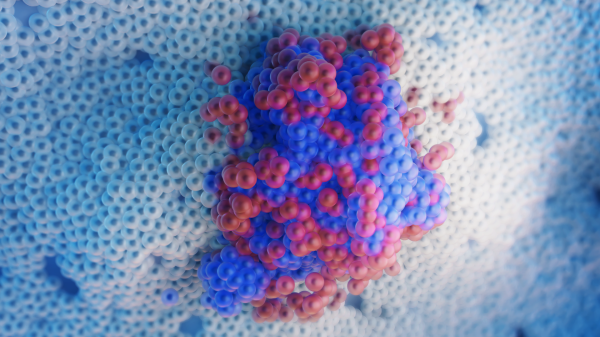
From food crops to cancer clinics: Lessons in extermination resistance
Just as crop-devouring insects evolve to resist pesticides, cancer cells can increase their lethality by developing resistance to…
